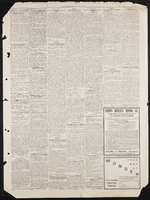Search the Special Collections and Archives Portal
Search Results

Interview with James Keith Magruder, November 22, 2004
Date
2004-11-22
Archival Collection
Description
Narrator affiliation: Assistant Manager for Operations, U.S. Department of Energy
Text
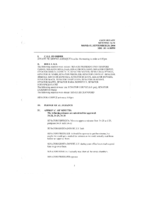
Meeting minutes for Consolidated Student Senate, University of Nevada, Las Vegas, September 20, 2004
Date
2004-09-20
Archival Collection
Description
Includes meeting minutes and agenda, along with additional information about Red Bull sponsorship agreement. CSUN Session 34 Meeting Minutes and Agendas.
Text
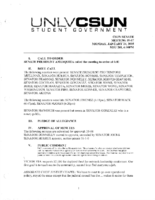
Meeting minutes for Consolidated Student Senate, University of Nevada, Las Vegas, January 24, 2005
Date
2005-01-24
Archival Collection
Description
Includes meeting minutes and agenda, along with additional information about bylaws and performance agreements.
Text
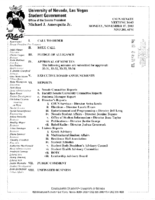
Meeting minutes for Consolidated Student Senate, University of Nevada, Las Vegas, November 17, 2004
Date
2004-11-17
Archival Collection
Description
Includes meeting agenda and minutes, along with additional information about bylaws.
Text
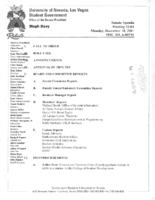
Meeting minutes for Consolidated Student Senate University of Nevada, Las Vegas, December 10, 2001
Date
2001-12-10
Archival Collection
Description
Includes meeting agenda and minutes , a senate resolution, and rules for the 32nd senate session.
Text
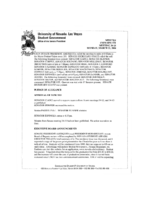
Meeting minutes for Consolidated Student Senate, University of Nevada, Las Vegas, March 22, 2004
Date
2004-03-22
Archival Collection
Description
Includes meeting minutes, along with additional information about letters.
Text

Interview with Patrick Rowe, November 5, 2004
Date
2004-11-05
Archival Collection
Description
Narrator affiliation: Drilling Engineer, Reynolds Electrical and Engineering Company (REECo)
Text
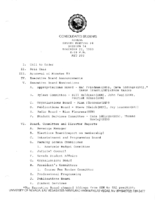
Meeting minutes for Consolidated Student Senate, University of Nevada, Las Vegas, November 22 1983
Date
1983-11-22
Archival Collection
Description
Includes meeting agenda and minutes along with additional information about the memorandum and senate bylaws.
Text
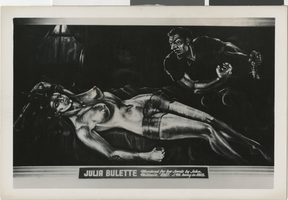
Postcard of Julia Bulette and John Millain scene, Virginia City, Nevada, 1867 - early 1900s
Date
1867 to 1939
Archival Collection
Description
An artist's depiction of Julia Bulette's theft and murder by John Millain. The caption on the front of the card reads: "Julia Bulette; Murdered for her Jewels by John Millain, 1887. J. M hung in 1868." A lengthy description printed on the back of the card reads: "Julia Bulette came to Virginia City while it was still a raw camp, and was soon among its best known figures. Reputedly a French Creole from New Orleans, tall, dark, lithe and witty, she was no ordinary lady of the line. Her secret charities were innumerable, her public services many, and her entertainments memorable for both cuisine and conversation. During the deadly black-water plague of 1861, she made her house into a hospital, nursed the stricken miners, and pawned her belongings to help their families. She was chosen an honorary member of Engine Company Number 1, but, not content with honorary status, attended the fires, worked a stirrup pump, and served refreshments to the Company afterwards. She was not one to seek obscurity or tolerate condescension. In the flush years of the first boom, she paraded C Street daily in a coach with four aces fanned upon the door, and sat nightly in her own box at the opera house, with a sable cape across her shoulders. When the ladies of the upper city sought to confine her activities, she retaliated by crashing their parties and making them her own. As a result, her violent death during the night of January 20, 1867, precipitated a cold war of the sexes. When her funeral procession, long, entirely masculine, and led by a band playing a dead-march, moved out B Street toward Old Flowery Cemetery, the wives in the hill mansions sat behind closed doors and drawn shutters, though even those could not defend them from the sprightly, returning strains of "The Girl I Left Behind Me." And conversely, when John Millain was arrested, some months later, after selling articles recognized as Julie's, his trial by the men was something less than impartial, but he was constantly visited in prison by women who showered him with gifts and tears. That his hanging, in April of 1868, drew the largest crowd in Virginia's history to the hollow north of town where the gallows was erected, the women to the ringside seats and the men to the slopes behind them, was less a tribute to Millain himself than a result of the fact that he was dying as the murderer of Julie Bulette, more nearly a Queen of the Comstock than any of her wealthy "betters" who vied for the title. "Sazarac" Virginia City, Nevada."
Image
Pagination
Refine my results
Content Type
Creator or Contributor
Subject
Archival Collection
Digital Project
Resource Type
Year
Material Type
Place
Language
Records Classification

